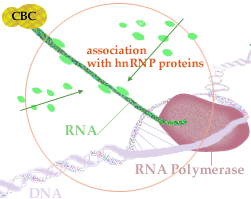hnRNP-ProteinsA large set of proteins has
been identified that binds to pre-mRNA.These proteins
have been named hnRNP proteins (hnRNA is a historic
name for
RNA in the cell
nucleus, much of which is pre-mRNA). Several
different hnRNP-proteins bind to the same
pre-mRNA
immediately as the
RNA is transcribed
and an RNA-protein complex is formed. The hnRNP proteins presumably have several different functions, but these are not well known yet. It has been assumed that hnRNP proteins help package the pre-mRNA into functional complexes. For example, hnRNP proteins may be involved in presenting the pre-mRNA to the splicing machinery. It is known that hnRNP A1 protein can influence the choice of splice sites in pre-mRNA. Three hnRNP-proteins have been shown to be involved in the transport of mRNA to the cytoplasm. The hnRNP C protein contains a retention sequence that appears to prevent mRNA from being transported out of the nucleus and hnRNP A1 and hnRNP K each contain an export signal as part of their amino acid chain. It is further possible that hnRNP proteins play a role also in the cytoplasm. The hnRNP A1 protein has been shown to accompany the mRNA into the cytoplasm and is present during translation. |
